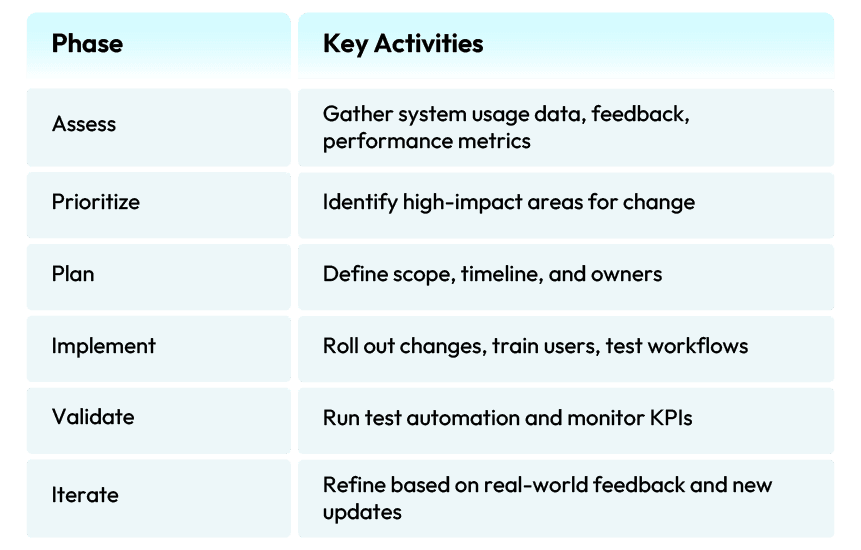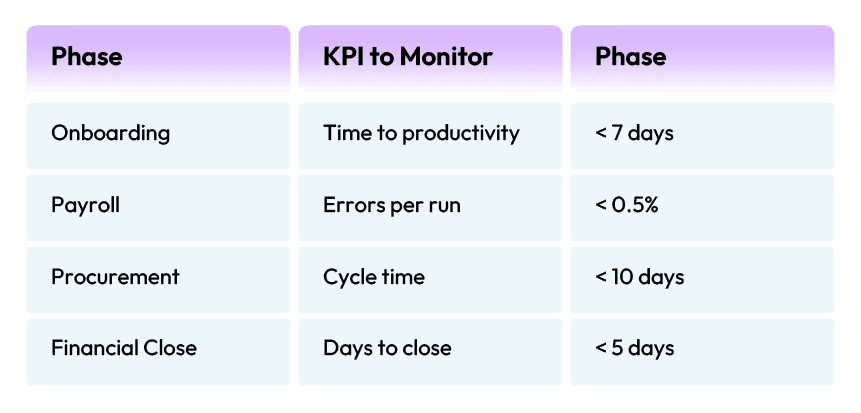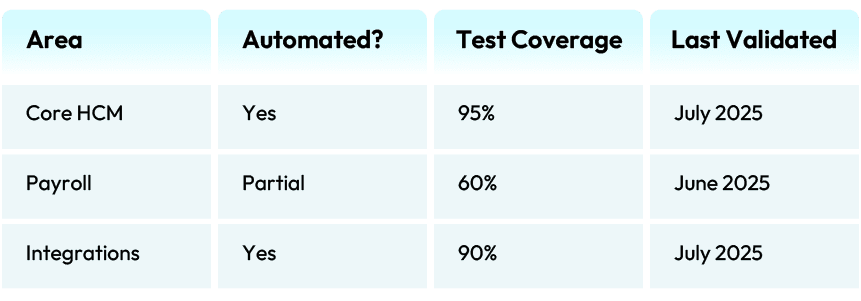Enterprise applications—like Workday, Oracle Cloud, and Coupa—are more than just software platforms. They’re the foundation of your business processes: from hiring and payroll to procurement and financial reporting. But the implementation of these tools is only the beginning. True value comes from continuous improvement—an intentional, ongoing effort to optimize how your business runs on these systems.
In today’s fast-evolving business landscape, keeping your enterprise applications static means falling behind. The key to long-term success is ensuring that your systems—and more importantly, your business processes—stay aligned with your evolving goals. That’s what this blog is all about: how to future-proof your business by managing your enterprise applications as living, evolving assets.
What Does Continuous Improvement Really Mean?
Continuous improvement in the enterprise application lifecycle refers to the ongoing process of evaluating, refining, and enhancing business processes that are supported by core enterprise technology. It goes beyond reactive maintenance or system upgrades—it’s about proactively identifying inefficiencies, adapting to regulatory and market changes, and embedding agility into the fabric of your operations.
Whether it’s streamlining the employee onboarding experience in Workday, reducing procurement cycle times in Coupa, or enhancing financial close accuracy in Oracle Cloud, improvement needs to be process-led and data-informed.
Why It Matters More Than Ever
According to reports, nearly 50% of enterprises don’t realize the expected ROI from their enterprise systems. One major reason? Organizations often treat go-live as the finish line rather than the starting point of optimization.
Business needs change. Market pressures intensify. Regulations shift. If your enterprise applications aren’t continuously optimized, they’ll become outdated quickly—dragging down agility, compliance, and user satisfaction.
Read more: The Return of the Clerk: Agentic AI in Enterprise Apps
Framework: Continuous Improvement Lifecycle
Here’s a simplified cycle your team can follow post-go-live:

Pillars of Continuous Improvement
Here’s how leading enterprises approach continuous improvement across the enterprise application lifecycle:
1. Performance Monitoring & Health Checks
Regular system reviews help ensure your apps are running efficiently. But it’s not just about uptime—it’s about process performance.
- Are your HR teams spending too much time on manual entries?
- Is your procure-to-pay cycle lagging behind benchmarks?
- Are approval bottlenecks delaying decision-making?

2. Feedback Loops from Business Users
Your employees are the front line of your enterprise apps. Set up easy ways for them to report friction, propose improvements, and highlight gaps. Integrate this feedback into your optimization roadmap.
Encouraging continuous feedback drives adoption, satisfaction, and innovation.
3. Automation and Testing as Enablers
Change is only helpful if it’s reliable. Automating repetitive tasks and regression testing is crucial to ensure new features and configurations don’t break existing processes.
How Testing Supports Continuous Improvement:
- Quickly test new features before adoption
- Detect unintended impact from updates
- Automate regression testing for ongoing cycl

Pro Tip: Platforms like Opkey empower business users to create and execute tests without writing code, making continuous testing more scalable.
Read more: What Organizations Forget When Automating Enterprise Application Testing
4. Agility Through Innovation
Are you leveraging AI-driven insights? Is your system compatible with your evolving data strategy? Are you adopting new modules or partner apps when needed?
Modern platforms like Opkey solve this with:
- AI-powered test automation to instantly validate changes across Workday or other ERP platforms
- Impact analysis that shows what’s affected by vendor updates before you deploy
- Self-healing scripts that adapt to UI or logic changes without rewriting tests
- Cross-platform testing for integrations with Salesforce, ServiceNow, SAP, etc.
By automating the grunt work, you free up your teams to focus on strategic transformation, not troubleshooting.
Technology is changing fast. The most mature enterprises are the ones who can adapt with minimal disruption.
How to Foster a Culture of Continuous Improvement
- Cross-functional ownership: Involve HR, finance, IT, and operations in prioritizing optimization initiatives.
- Track meaningful KPIs: Don’t just measure system uptime—measure process velocity, accuracy, and satisfaction.
- Invest in lifecycle tools: Enterprise testing tools, process mining, and impact analysis software are key enablers.
- Embed iteration in governance: Regularly review what’s working, what’s not, and what needs to change.
Keep Moving Forward
Continuous improvement is not a luxury—it’s a necessity. In a world where agility wins, your business processes need to evolve alongside your enterprise applications.
From faster payroll cycles to smarter compliance checks, small process improvements can drive major results. With the right tools, mindset, and partners, your team can turn your enterprise applications into a true engine for innovation and resilience.
Want to learn how Opkey helps teams continuously optimize their Workday, Oracle, and Coupa environments? See how we help with enterprise application lifecycle.



